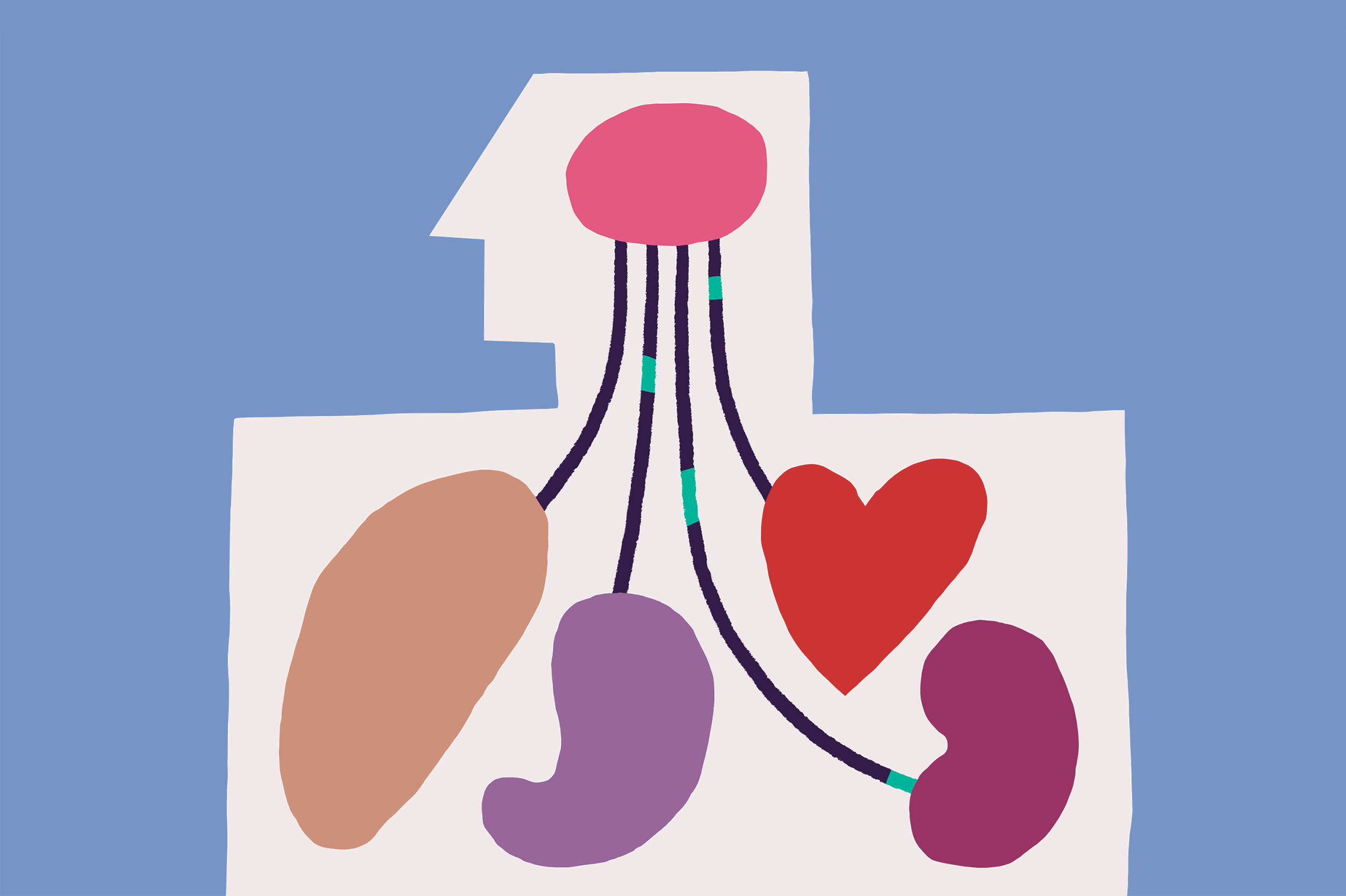What can the science of interoception teach us about diagnosing and treating mental illness?
When we feel anxious or excited we might say that we have “butterflies in our stomach,” and when we have a hunch about something, we might say that we have a “gut feeling” about it. Such sensations are a small component of the milieu of signals arising from inside our bodies—others include sensations of hunger, thirst, a full bladder, and those we’re not usually aware of, like signals associated with our breathing and the beating of our hearts.
All of these signals are closely linked to homeostatic control, a complicated biological process of tissue monitors and molecular triggers in the body that act to alert the brain about our internal condition, so that our physiological needs are met, and so our ability to sense these internal bodily signals—referred to as interoception—is a vital component of self-consciousness.
Many of these signals are processed unconsciously, but they occasionally enter our conscious awareness. For example, we typically pay little or no attention to our heartbeats, but we become acutely aware of our heart pounding when we are angry or scared. And we don’t slowly become aware of feelings of hunger and thirst. They enter our awareness quickly—suddenly we feel starved or parched. These feelings are thrust there by the brain because they signal bodily deficiencies that need to be acted upon with some urgency.
Interoceptive signals play an important role in how we feel and what we think. As well as having a strong influence on our emotional states, they also subtly affect how we perceive the outside world, and can influence decision making and other cognitive processes in various ways. And it is now becoming increasingly clear that processing of these signals goes awry in a wide variety of mental health disorders. This realization not only provides a fresh perspective on these conditions but opens up new avenues for how they might be treated more effectively. But appreciation of the importance of interoception is also being exploited to sell quack remedies and services.
“Interoception may be a missing variable in psychiatric treatment, which may be important in certain groups of patients who have extreme bodily experiences,” says Camilla Nord, principle investigator at the Mental Health Neuroscience Lab at the University of Cambridge, adding that profound physical changes are common in patients with anxiety and depression. These so-called “somatic” symptoms can be very debilitating, but aren’t explained well in traditional ways. “Interoception-based treatments may be a path to treatments for people [with such symptoms] who we cannot treat very well at the moment.”

I feel therefore I am
The idea that internal bodily signals play a role in what we think and feel is not new. In the late nineteenth century, William James, the father of psychology, stated somewhat counterintuitively that emotions arise from bodily sensations and not vice versa: “The bodily changes follow directly the PERCEPTION of the exciting fact [and] our feeling of the same changes as they occur IS the emotion… we feel sorry because we cry, angry because we strike, afraid because we tremble and not that we cry, strike, or tremble, because we are sorry, angry, or fearful, as the case may be.”
In the 1950s and 60s, the pioneering German-American psychoanalyst Hilde Bruch recognized that disturbances of interoception play an important role in anorexia nervosa.
In a seminal 1962 paper, Bruch states that one “outstanding characteristic of the anorexic patient is a disturbance in the accuracy of perception or cognitive interpretation of stimuli arising in the body, with failure to recognize signs of nutritional need as the most prominent deficiency of this type.” This disturbance, she adds, is “more akin to inability to recognize hunger than to mere loss of appetite… Awareness of hunger and appetite in the ordinary sense seems to be absent… Even though occasionally hunger may become overwhelming in its biological urgency, usually there is denial and non-recognition of the pains of hunger, even in the presence of stomach contraction. On the other hand, there are complaints of acute discomfort and fullness after the intake of the smallest amount of food.”
“A person [with anxiety] might be hyper-aware of what’s going on inside their body, which distracts them from what they should be paying attention to on the outside.”
Interoception research eventually fell out of favor, but in the past 15 years or so, there has been renewed interest in the subject, and researchers have made advances in measuring various dimensions of interoception. One of these dimensions is interoceptive sensitivity, or the ability to accurately perceive internal bodily signals. This has typically been measured with the so-called heartbeat perception task, in which one is asked to focus on, and then try to count, their heartbeats for 1 minute, after which the estimate is compared to the actual number of heartbeats, as measured objectively by electrocardiogram. Another is interoceptive sensibility, or our own self-perception of how sensitive we are to interoceptive signals, which is usually determined by questionnaires and may not be entirely accurate. And a third is interoceptive awareness, or one’s actual awareness of their own interoceptive accuracy.
These measures are related to but distinct from one another. Many people claim to be completely attuned to their bodies but are not so objectively and vice-versa. For example, one individual who believes that they are highly sensitive to interoceptive signals and therefore can count their heartbeats accurately, may have a low interoceptive accuracy score, whereas another who doesn’t have much confidence in their abilities may in fact count their heartbeats very accurately. Crucially, how these measures differ widely between individuals seems to be particularly relevant to certain psychiatric disorders.
Anxiety, depression, and suicide
For example, various studies show that people with anxiety disorders exhibit altered interoceptive abilities. “A person [with anxiety] might be hyper-aware of what’s going on inside their body, which distracts them from what they should be paying attention to on the outside,” says Nord, “or they might have relatively normal interoception, but their feelings have negative connotations that make them feel uncomfortable. There might be a disconnect between their physiological state and their beliefs about it, so you wouldn’t necessarily want to damp down interoceptive signals, but change their interpretation of it.”
Clinical depression is characterized by a wide variety of bodily alterations and physical dysfunctions, collectively referred to as somatic symptoms. People who are depressed most often experience sleep disturbances and loss of appetite, but other somatic symptoms include fatigue, dizziness, headaches, palpitations, tightness of the chest, loss of libido, weight change, and hair loss. These are closely associated with the disturbances in thought processes that occur in depression and tend to appear and disappear with them. But exactly why they are so closely related is still unclear.
“You could argue that several of the diagnostic features of depression are interoceptive in nature,” says Sahib Khalsa, an associate professor at the University of Tulsa. “What leads a depressed individual to eat less or eat more? There’s a sensory aspect—they have to sense their appetite, or at least connect at a cognitive level with an inferred body state.”
Traditional treatments target the cognitive symptoms—they assume that the sole cause of the disease is found in the brain, and they ignore the role of the body. The brain does indeed play an important role in depression, but there is growing evidence that the body is also important and that both bodily signaling and interoception are altered in depression. Studies show, for example, that major depressive disorder appears to be associated with reduced interoceptive accuracy, with people who are depressed showing less accurate heartbeat perception than non-depressed matched controls.
It is becoming clear that the immune system plays a role in depression, too, with signaling molecules called cytokines in particular being implicated. Cytokines are small proteins that play a role in stress and inflammation, which communicate with the brain via the vagus nerve and other peripheral nerves to modify its activity.
A brain region called the insula is known to be crucial for interoception, as it receives and processes sensory signals from inside the body (hence, it is often referred to as the primary interoceptive cortex). The insula is activated to a greater or lesser extent during the heartbeat perception task, depending on how accurately an individual performs on the task, and numerous studies show that both its structure, function, and connectivity are altered in depression.
Research also suggests that interoception is disturbed in people who attempt suicide. Khalsa and his colleagues have compared how psychiatric patients with and without a history of suicide attempts performed on several uncomfortable tasks requiring the detection of bodily signals. Those with a history of suicide attempts could hold their breath and keep their hand in icy water for significantly longer periods of time than those who had not attempted suicide in the past. Those same people also performed worse on the heartbeat perception task. The researchers hypothesize that people who attempt suicide exhibit what they called “interoceptive numbing,” which makes them more tolerant to unpleasant sensations and less aware of other sensations, and that blunted interoception makes them less responsive to bodily threats, which could contribute to suicidal behavior.
Biofeedback, flotation, and body-oriented therapy
Some research groups are exploring interoceptive training as a potential treatment for mental health disorders. One approach involves mindful awareness in body-oriented therapy to improve awareness of interoceptive signals in people who have difficulty identifying them, in the hope that they may better regulate their emotions. Another approach involves the use of biofeedback to improve interoceptive accuracy.

“I’m very interested in that prospect, training interoceptive sensitivity with biofeedback, but it’s a very fast-moving field, and people are really not sure which interoceptive measures are most important and which should be trained,” says Nord. “One idea in psychiatry is that we should be moving away from one-size-fits-all treatments. Who would benefit most from treatments targeting interoception? It could be a very rich area for tailoring treatments for people who would benefit from it.”
Khalsa agrees. “There’s probably a role for personalized interoceptive treatment, and it would be nice to have a treatment that’s targeting a known pathophysiology, but we’re still discovering what these are,” he says. In depression, he adds, “there are so many different combinations of symptoms that can occur in an individual to arrive at a diagnosis, but we still don’t really understand the pathophysiology to say that a particular set of symptoms has abnormalities in these particular pathways.”
There are a few existing treatments that target interoceptive processes. “One good example is carbon dioxide exposure, which is used to treat panic disorder,” says Nord. “It’s a type of physical exposure therapy, and the idea is that exposing people to this stressful interoceptive change makes them better able to deal with their own physiological stress.”
Another treatment, which Khalsa and his colleagues have found effective for panic disorder, is floatation therapy. “We don’t necessarily know the mechanism,” he says, “but the humidity of the floatation device stimulates the respiratory system, and the therapy heightens interoceptive sensations and lowers stress, muscle tension, and anxiety.” In a more recent study, Khalsa and his colleagues demonstrated the safety of the method for people diagnosed with anorexia. The study also showed that as well as improving their interoceptive awareness, it also reduced their anxiety and body image disturbance.
Floatation therapy may have more use as an adjunctive tool to enhance existing treatments,” says Khalsa. “If we can add new treatments to the clinician’s armamentarium, that could lead to a more personalized approach to psychiatric treatment.”
Yet, as interoception research flourishes, so, too, does its potential to be exploited. “Unfortunately, I’ve already seen this—there are charlatans in every field, and a lot of people in alternative medicine have now found some scientific basis [to support their own claims],” says Nord. “It’s a real danger that our findings are being used in this way. The irony is that this new age mantra, ‘listen to your body,’ is not always true, and is not good advice for everybody. For some people it’s more like ‘listen less to your body.’”
















